Steven L. Kent (born August 28, 1960) is an American writer, known for both video game journalism and military science fiction novels. He is the son of woodworker Ron Kent.
Steven L. Kent (born August 28, 1960) is an American writer, known for both video game journalism and military science fiction novels. He is the son of woodworker Ron Kent.
In 1993, Steven started work as a freelance journalist, writing monthly video game reviews for the Seattle Times . He eventually became a contributor to such video game publications as Electronic Games, Next Generation, and Computer Entertainment News, as well as such mainstream publications as Parade, USA Today , the Chicago Tribune , MSNBC , the Japan Times , and the Los Angeles Times Syndicate . He also wrote entries on video games for Encarta and the Encyclopedia Americana.
In 2005, Steve announced that he would concentrate on writing novels. In 2006, he published The Clone Republic and Rogue Clone. In 2007, he published The Clone Alliance. [1]
Kent received a B.A. in 1986 and an M.A. in 1990, both from Brigham Young University.

Pong is a table tennis–themed twitch arcade sports video game, featuring simple two-dimensional graphics, manufactured by Atari and originally released in 1972. It was one of the earliest arcade video games; it was created by Allan Alcorn as a training exercise assigned to him by Atari co-founder Nolan Bushnell, but Bushnell and Atari co-founder Ted Dabney were surprised by the quality of Alcorn's work and decided to manufacture the game. Bushnell based the game's concept on an electronic ping-pong game included in the Magnavox Odyssey, the first home video game console. In response, Magnavox later sued Atari for patent infringement.

Star Wars is an American epic space opera multimedia franchise created by George Lucas, which began with the eponymous 1977 film and quickly became a worldwide pop culture phenomenon. The franchise has been expanded into various films and other media, including television series, video games, novels, comic books, theme park attractions, and themed areas, comprising an all-encompassing fictional universe. Star Wars is one of the highest-grossing media franchises of all time.
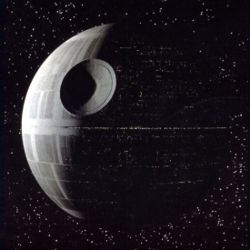
The Death Star is a space station and superweapon featured in the Star Wars space-opera franchise. Constructed by the autocratic Galactic Empire, the Death Star is capable of annihilating entire planets into rubble, and serves to enforce the Empire's reign of terror. Appearing in the original 1977 film Star Wars, the Death Star serves as a central plot point and setting for the movie, and is destroyed in an assault by the Rebel Alliance in the climax of the film. A larger Second Death Star is constructed in the events of the film Return of the Jedi featuring substantially improved capabilities compared to its predecessor. It is destroyed by the Rebel Alliance while under construction, however.
In the history of video games, the fourth generation of video game consoles, more commonly referred to as the 16-bit era, began on October 30, 1987, with the Japanese release of NEC Home Electronics' PC Engine. Though NEC released the first console of this era, sales were mostly dominated by the rivalry between Sega and Nintendo across most markets: the Sega Mega Drive and the Super Nintendo Entertainment System. Cartridge-based handheld consoles became prominent during this time, such as the Nintendo Game Boy (1989), Atari Lynx (1989), Sega Game Gear (1990) and TurboExpress (1990).
The golden age of arcade video games was the period of rapid growth, technological development and cultural influence of arcade video games, from the late 1970s to the early 1980s. The period began with the release of Space Invaders in 1978, which led to a wave of shoot 'em up games such as Galaxian and the vector graphics-based Asteroids in 1979, made possible by new computing technology that had greater power and lower costs. Arcade video games transitioned from black-and-white to color, with titles such as Frogger and Centipede taking advantage of the visual opportunities of bright palettes.
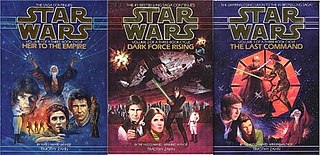
The Thrawn trilogy, also known as the Heir to the Empire trilogy, is a trilogy of novels set in the Star Wars universe, written by Timothy Zahn between 1991 and 1993. The first book marked the end of the notable drought of new Star Wars material during a four-year period from the tenth anniversary of the original 1977 film's release to the release of Heir to the Empire in 1991.
1980 saw the release of a number of games with influential concepts, including Pac-Man, Battlezone, Crazy Climber, Mystery House, Missile Command, Phoenix, Rally-X, Space Panic, Stratovox, Zork, Adventure, and Olympic Decathlon. The year's highest-grossing video game was Namco's arcade game Pac-Man, while the best-selling home system was Nintendo's Game & Watch. The Atari VCS also grew in popularity with a port of Space Invaders and support from new third-party developer Activision.
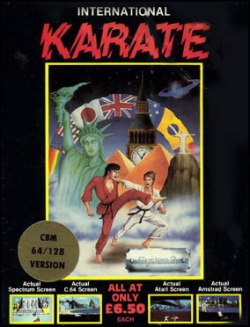
International Karate is a fighting game developed and published by System 3 for the ZX Spectrum in 1985 and ported to various home computers over the following years. In the United States it was published by Epyx in 1986 as World Karate Championship.

Over one hundred video games based on the Star Wars franchise have been released, dating back to some of the earliest home consoles. Some are based directly on films while others rely heavily on the Star Wars Expanded Universe.
James Swallow is a British author. A BAFTA nominee and a New York Times, Sunday Times and Amazon #1 best-seller, he is the author of several original books and tie-in novels, as well as short fiction, numerous audio dramas and video games.

The Sega Genesis, known as the Mega Drive outside North America, is a 16-bit fourth generation home video game console developed and sold by Sega. It was Sega's third console and the successor to the Master System. Sega released it in 1988 in Japan as the Mega Drive, and in 1989 in North America as the Genesis. In 1990, it was distributed as the Mega Drive by Virgin Mastertronic in Europe, Ozisoft in Australasia, and Tectoy in Brazil. In South Korea, it was distributed by Samsung Electronics as the Super Gam*Boy and later the Super Aladdin Boy.
Karen Traviss is a science fiction author from Wiltshire, England. She is the author of the Wess'Har series, and has written tie-in material based on Star Wars, Gears of War, Halo, G.I. Joe and the newest Nomad Series working with Nick Cole and Jason Anspach. Her work crosses various forms of media including novels, short stories, comics, and video games.

John Jackson Miller is an American science-fiction author, comic book writer, and commentator, known for his work on the Star Wars franchise and his research into comic book circulation history, as presented in the Standard Catalog of Comic Books series and the Comichron website.

Star Wars Miniatures is a 34mm scale collectible miniatures tabletop game based on the Star Wars fictional universe that was produced by Wizards of the Coast. The game was originally released in September 2004 and continued production until May 2010. Star Wars Miniatures players build point-based squads from one of ten different in-universe factions then conduct battles between those squads. The game mechanics are a simplified version of the d20 roleplaying game system. Multiple maps, scenarios, and set themes from different settings and time periods from within the Star Wars universe are available.
In the history of video games, the first generation era refers to the video games, video game consoles, and handheld video game consoles available from 1972 to 1983. Notable consoles of the first generation include the Odyssey series, the Atari Home Pong, the Coleco Telstar series and the Color TV-Game series. The generation ended with the Computer TV-Game in 1980, but many manufacturers had left the market prior due to the market decline in the year of 1977 and the start of the second generation of video game consoles.
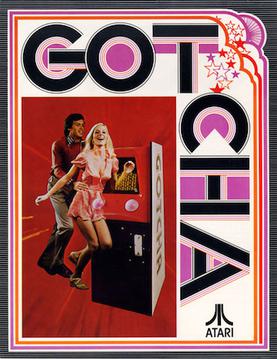
Gotcha is an arcade video game developed by Atari and released in October 1973. It was the fourth game by the company, after the 1972 Pong, which marked the beginning of the commercial video game industry, and the 1973 Space Race and Pong Doubles. In the game, two players move through a maze, which continually changes over time. One player, the Pursuer, attempts to catch the other, the Pursued; if they do, a point is scored, and the players reset positions. The game emits an electronic beeping sound, which increases in pace as the Pursuer gets closer to the Pursued, and each game lasts a set amount of time.
Star Wars has been expanded to media other than the original films. This spin-off material is licensed and moderated by Lucasfilm, though during his involvement with the franchise Star Wars creator George Lucas reserved the right to both draw from and contradict it in his own works. Such derivative works have been produced concurrently with, between, and after the original, prequel, and sequel trilogies, as well as the spin-off films and television series. Commonly explored Star Wars media include books, comic books, and video games, though other forms such as audio dramas have also been produced.
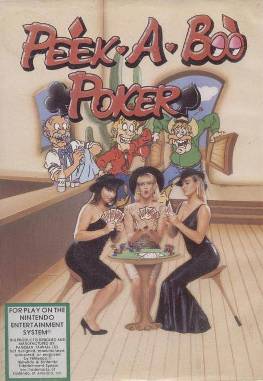
Peek-A-Boo Poker, is a video game made by the company Idea-Tek and distributed by Hacker International/Panesian in 1991 as one of their three pornographic video games for NES, the other two being Magic Bubble and Hot Slots.
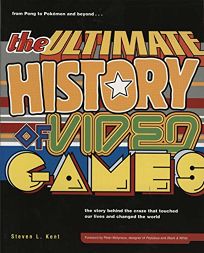
The Ultimate History of Video Games is a 2001 non-fiction book by Steven L. Kent. Published initially by Prima Publishing and then by Three Rivers Press, it is an updated version of the self-published The First Quarter: A 25-Year History of Video Games.